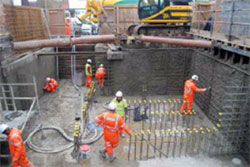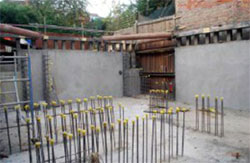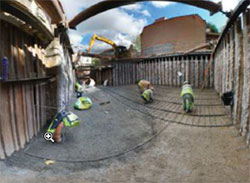With a population of over 8.17 million people, the city of London, England, continues to grow. The most recent census. released in 2012, reported a population increase of 12% over the past 10 years. This makes London the fastest-growing city in England.
Hampstead, part of the Borough of Camden in Inner London, is known for some of the most expensive housing in the city. The village of Hampstead has more millionaires within its boundaries than any other area of the United Kingdom. As Hampstead village is located near many transit hubs, it is known as one of Londons “Urban Villages? This, along with the tight urban growth boundaries in such a desirable neighborhood. has resulted in clusters of high-density development.

After a unique piling system was developed and implemented for this project, shotcrete containing KIM crystalline waterproofing admixture was applied to the slab and walls of the basement (Photo courtesy of Abbey Pynford – Basement Engineering Specialists)
Tight Spaces
With no room to grow outwards, many people outgrowing their current homes have chosen to expand downward., creating subterranean extensions which can sometimes triple the size of the street-level home.
When homeowners in Hampstead wanted to construct a new home with a basement in the already-dense neighborhood, they knew construction would be a challenge, The proposed basement filled the footprint of the restricted site entirely; sandwiched between two existing luxury homes and immediately adjacent to the narrow road. The local geology, consisting of clays with sandy gravel lenses, gave rise to a very unpredictable hydro geology (the distribution and movement of groundwater in t.he soil). This, coupled with the site being located on a hill, created a unique and complicated hydrological circumstance. One thing was certain: the below-grade structure would need a permanent waterproofing solution for the concrete, which could withstand high hydrostatic pressure.
The requirement to achieve the largest possible internal space, without affecting adjoining homes, considerably limited the techniques that could be used both to construct and waterproof the structure, The final design also called for an exposed architectural concrete finish to the internal face of the perimeter walls.

The integral crystalline waterproofing method also improved the shotcrete mixture’s workability and gave the finished product a smoother architectural appearance (Photo courtesy of Abbey Pynford – Basement Engineering Specialists)
Waterproofing Choices
In accordance with the British Structural Waterproofing Association code of practice for protection of below-grade structures against water from the ground (BS 8102), when exposed concrete finishes are specified, only Type A or B systems are possible as concrete waterproofing options. Type A is defined as “Tanking Protection” and uses an external barrier system otherwise known as “Sheet Membranes,” Water resistance is achieved by waterproofing products applied either externally, internally, or sandwiched between two elements of the structure. Type B systems, or “Structurally Integral Protection” rely entirely on the concrete structure to prevent water ingress. An additive is added to the concrete mixture at the time of batching or on site, and waterproofs the concrete from within. Integral concrete waters proofing systems can be densifiers, water repellents, or crystalline admixtures, One major drawback to the Type A system in this instance was that these types of systems require significant space around the perimeter for installation, so the design would not be able to take full advantage of the property footprint. A Type B solution was ultimately selected for this project. Kryton’s Krystol Internal Membrane (KIM), a hydrophobic crystalline concrete water-proofng admixture, was chosen for its workability and quality control. As a product fully meeting the requirements of the American Concrete Institutes (ACI’s) standard classification of permeability-reducing admixtures under hydro- static conditions (PRAHs)> KIM was the perfect choice for this type of application.

Using shotcrete and KIM together allowed the basement to be constructed right to the property line without affecting the neighboring homes (Photo courtesy of Abbey Pynford – Basement Engineering Specialists)
A Unique Approach
Abbey Pynford a company specializing in ground engineering work, was brought on board to execute the tricky basement construction. With 25 years of experience in specialist ground engineering, a new innovative piling design and technique was developed and designed specifically for this job. This technique – combining the process of mini pile installation, using sectional auger bore string with plunged UC structural steel sections—was necessary to ensure that the basement area could be excavated safely. It was critical that this was accomplished without damaging the two bordering properties, but at the same time providing the absolute maximum internal space. The pile was formed by a restricted access rig weighing 1.7 tonnes (3750 lb) drilling into the ground with an auger string to the required depth. A pre-blended micro-concrete mixture was then pumped down the open pile bore whilst the structural steel section was plunged. A shalt of micro concrete was thus formed, reinforced with a structural steel section.
This unique technique enabled the perimeter of the basement to be formed with the piles retaining the adjacent soils. It also enabled the structures with piles to be half the depth and 70% the width of those formed using traditional steel reinforcement.
When it came to deciding on the best method of concrete application to form the internal reinforced concrete lining wall for the installed piles, Abbey Pynford turned to a shotcrete application. Lining the walls with shotcrete carried the benefit of minimizing the joints in the concrete and accelerating production time. Speeding up the wall installation by using shotcrete significantly reduced costs associated with labor and materials that would have been needed to erect formwork for a cast-in-place method.
KIM is known to be very compatible with shotcrete, not only waterproofing permanently and effectively but also by improving workability. The proprietary admixture effectively makes the shotcrete mixture more plastic and allows creation of a higher-end architectural finish to the concrete walls without requiring sealers or finishers. By using KIM, the shotcrete’s permeability was successfully reduced and permanent waterproof protection was ensured, To do this, KIM’s hydrophobic chemicals react with water or moisture, growing millions of permanent, needle-like crystals throughout the concrete matrix, blocking the movement of water in all directions. These crystals then remain dormant in the concrete, and if new hairline cracks (up to 0.5 mm [0.02 in]) form, the crystals will react with any incoming water to “self-seal” the hairline crack and maintain a watertight barrier KIM is an effective water? proofing system for rigid concrete structures only and may not reliably seal cracks and joints that experience variable loading or repeated movement.
Using shotcrete also enabled Kryton’s crystalline jointing techniques and associated products (Krystal Waterstop System) to be applied in improved working conditions where necessary, allowing enhanced waterproofing protection to the most vulnerable areas. The KIM/shotcrete mixture was used to waterproof the basement floor slab, lower ground floor slab, and basement walls, and the Krystol Waterstop System was used for all the basement joints Using shotcrete and KIM together effectively reduced construction time by 30%. The owners were very pleased with the results and impressed with the weed of the work.
Where Were Kryton Products Used?
| Product Used | Used Where | Quantity | |
| Product 1 | KIM HS | Basement floor slab, lower ground floor slab, lining walls | 82 m3 (107 yd3) |
| Product 2 | Treatment | Construction joints from slabs to lining walls | 17 m2 (180 ft2) |
| Product 3 | Internal grout | Construction joints from slabs to lining walls | 82 m (270 ft) |
| Other products | External grout | Vertical construction joints to all lining wall – lining wall junctions | 13 m (43 ft) |
References
1. Hill, D, “London’s Population Up By 12% in 10 Years,” The Guardian, July 16, 2012, http://www.theguardian.com/uk/davehillblog/2012/jul/16/london-populations-rises-12.
2. BS 8102:2009, “Code of Practice for Protection of Below Ground Structures against Water from the Ground,” British Standards Institution, 2009, http://shop.bsigroup.com/ProductDetail/?pid=000000000030168198.
John Andersen
Territory Manager, Western Canada
Email: jandersen@kryton.com
Phone: 604-324-8280
With over 20 years’ experience supporting projects in the concrete and construction industries, John Andersen has spent the past six years of his career applying his knowledge and experience to concrete waterproofing projects throughout Western Canada and the Pacific Northwest USA with Kryton. John brings extensive technical knowledge, as well as a diverse history of hands on experience, to every Kryton waterproofing project he supports.
Source: Shotcrete Magazine